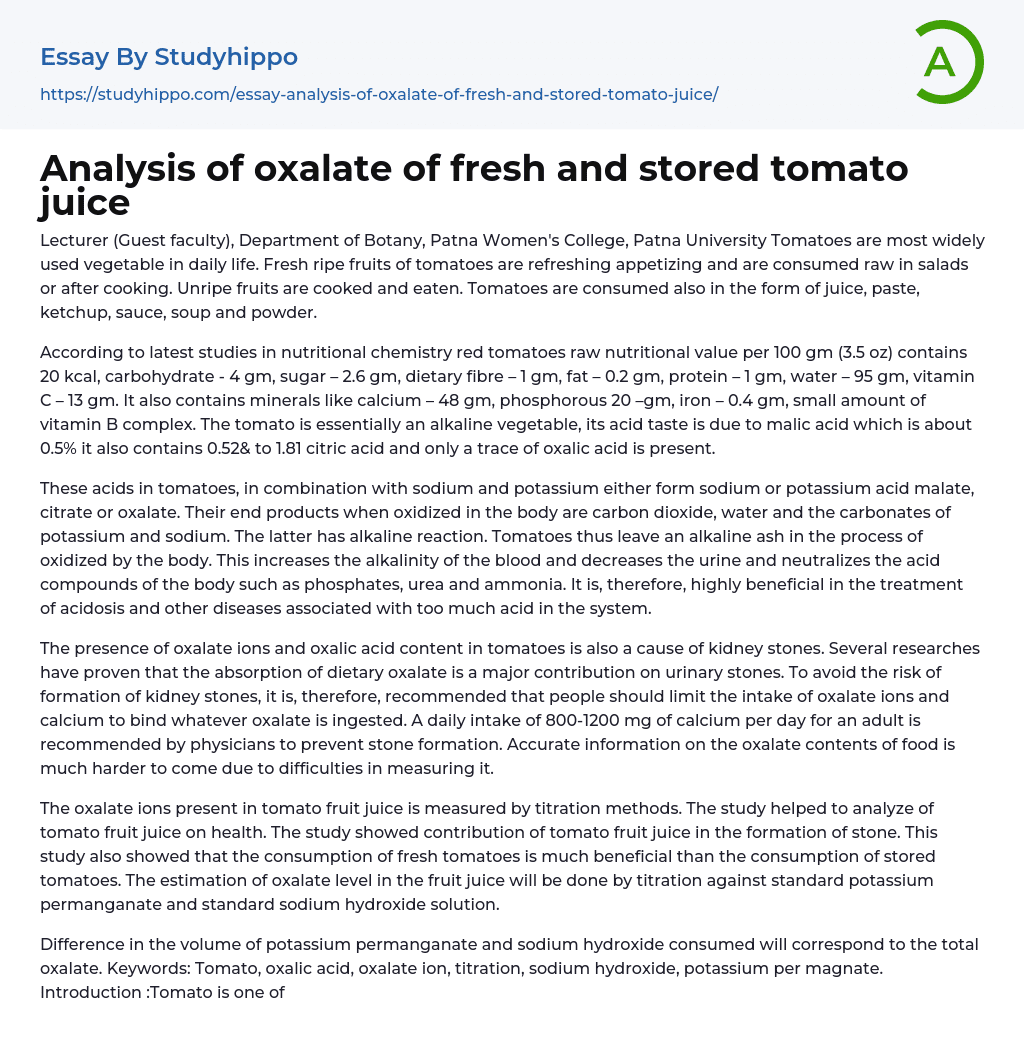

Analysis of oxalate of fresh and stored tomato juice Essay Example
Lecturer (Guest faculty), Department of Botany, Patna Women's College, Patna University Tomatoes are most widely used vegetable in daily life. Fresh ripe fruits of tomatoes are refreshing appetizing and are consumed raw in salads or after cooking. Unripe fruits are cooked and eaten. Tomatoes are consumed also in the form of juice, paste, ketchup, sauce, soup and powder.
According to latest studies in nutritional chemistry red tomatoes raw nutritional value per 100 gm (3.5 oz) contains 20 kcal, carbohydrate - 4 gm, sugar – 2.6 gm, dietary fibre – 1 gm, fat – 0.2 gm, protein – 1 gm, water – 95 gm, vitamin C – 13 gm. It also contains minerals like calcium – 48 gm, phosphorous 20 –gm, iron – 0.4 gm, small amount of vitamin B complex. The tomato is essentially an alkali
...ne vegetable, its acid taste is due to malic acid which is about 0.5% it also contains 0.52& to 1.81 citric acid and only a trace of oxalic acid is present.
These acids in tomatoes, in combination with sodium and potassium either form sodium or potassium acid malate, citrate or oxalate. Their end products when oxidized in the body are carbon dioxide, water and the carbonates of potassium and sodium. The latter has alkaline reaction. Tomatoes thus leave an alkaline ash in the process of oxidized by the body. This increases the alkalinity of the blood and decreases the urine and neutralizes the acid compounds of the body such as phosphates, urea and ammonia. It is, therefore, highly beneficial in the treatment of acidosis and other diseases associated with too much acid in the system.
View entire sample
justify">The presence of oxalate ions and oxalic acid content in tomatoes is also a cause of kidney stones. Several researches have proven that the absorption of dietary oxalate is a major contribution on urinary stones. To avoid the risk of formation of kidney stones, it is, therefore, recommended that people should limit the intake of oxalate ions and calcium to bind whatever oxalate is ingested. A daily intake of 800-1200 mg of calcium per day for an adult is recommended by physicians to prevent stone formation. Accurate information on the oxalate contents of food is much harder to come due to difficulties in measuring it.
The oxalate ions present in tomato fruit juice is measured by titration methods. The study helped to analyze of tomato fruit juice on health. The study showed contribution of tomato fruit juice in the formation of stone. This study also showed that the consumption of fresh tomatoes is much beneficial than the consumption of stored tomatoes. The estimation of oxalate level in the fruit juice will be done by titration against standard potassium permanganate and standard sodium hydroxide solution.
Difference in the volume of potassium permanganate and sodium hydroxide consumed will correspond to the total oxalate. Keywords: Tomato, oxalic acid, oxalate ion, titration, sodium hydroxide, potassium per magnate. Introduction :Tomato is one of the world's most popular and widely cultivated fruit vegetable. Fresh ripe fruits of tomatoes are refreshing appetizing and are consumed raw in salads or after cooking.
Unripe fruit area cooked and eaten. Tomatoes consumed area also in the form of juice, paste, ketchup, sauce and powder. Ripe tomatoes with bright red colour and high
acidity are used for the expansion of juice. It is sometimes seasoned to produce cocktail known as Tomato juice cocktail. Tomato juice is a nourishing beverage. It is prepared by dehydrating the juice. Tomato is rich in calcium, phosphorus, vitamin C and carbohydrate.
- Acid Rain essays
- Acid essays
- Calcium essays
- Carbohydrate essays
- Carbon essays
- Chemical Bond essays
- Chemical Reaction essays
- Chemical reactions essays
- Chromatography essays
- Concentration essays
- Copper essays
- Diffusion essays
- Ethanol essays
- Hydrogen essays
- Organic Chemistry essays
- Osmosis essays
- Periodic Table essays
- Ph essays
- Salt essays
- Sodium essays
- Titration essays
- Beef essays
- Beer essays
- Beverages essays
- Bread essays
- Burger essays
- Cake essays
- Coconut essays
- Coffee essays
- Cooking essays
- Crowd essays
- Cuisines essays
- Dairy essays
- Desserts essays
- Dinner essays
- Drink essays
- Fast Food essays
- Favorite Food essays
- Food Safety essays
- Food Security essays
- Food Waste essays
- Fruit essays
- Ginger essays
- Hamburger essays
- Ice Cream essays
- Juice essays
- Lemon essays
- Meal essays
- Meat essays
- Oreo essays



